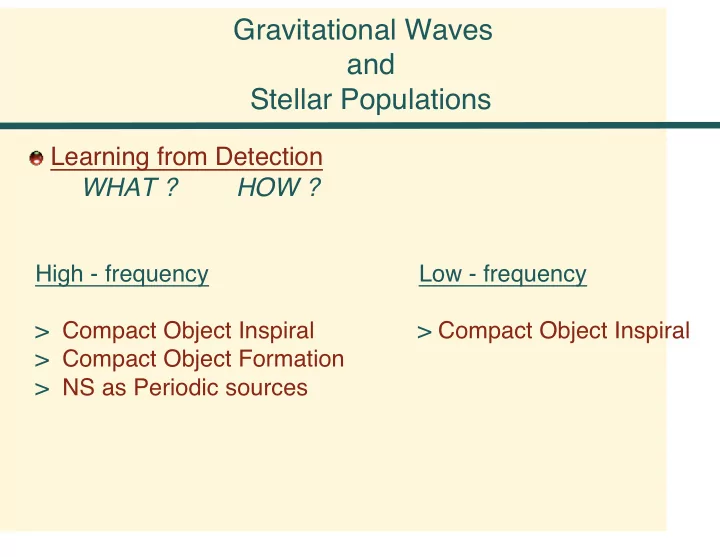

Gravitational Waves and Stellar Populations Learning from Detection WHAT ? HOW ? High - frequency Low - frequency > Compact Object Inspiral > Compact Object Inspiral > Compact Object Formation > NS as Periodic sources
Populations of Double Compact Objects Measured properties include: event rates masses of compact objects What we can learn about the astrophysics of stellar populations depends on whether a whole population of inspiraling double compact objects or just a few inspiral events have been detected GW observational selection effects and biases must be considered quantitatively
Populations of Double Compact Objects A. Event Rate measurements > even a few events can be used ( we know that !) > if more than one DCO types are detected relative inspiral rates can be derived for different DCO types ( NS-NS, BH-NS, BH-BH ) > comparison with theoretical rate predictions can constrain the systematic uncertainties in binary evolution models (e.g., stellar winds, details of mass transfer, SN kicks) > comparison to estimates of GRB rates
Populations of Double Compact Objects B. Mass measurements whole population detected: model fitting a few events detected: model exclusion (possibly with BH-BH ... ) or Bayesian analysis with theoretical models as priors either way: constraints on DCO formation models
Populations of Double Compact Objects For example: Models of Mass Distributions first SN second SN standard model weak stellar winds inefficient CE ejection Constraints on astrophysical models of DCO formation and on specifics of stellar evolutionary phases Belczynski et al. 2001
Populations of Double Compact Objects NS EOS Constraints: if inspiral signal shows evidence for the presence of NS e.g., merger signal characteristic of a NS (Faber & Rasio 2001) or association with a GRB and both of the measured masses exceed 1.5M o or 2.0M o if signal of NS disruption by a BH is detected: > NS radius measurement is possible (Vallisneri 2000) Note: fractional errors of ~ 10% needed for firm conclusions
Populations of Double Compact Objects Some Observational Biases: detection bias against massive binaries ( BH-NS & BH-BH ) > affects event rate estimates and relative inspiral rates > even without any corrections: treat inferred rates as limits and still constrain models detection bias against strongly precessing binaries > preferentially affects high-mass ratios ( BH-NS ) > if `mock' precessing templates are used, is parameter estimation possible ??? parameter estimation bias for sources at high redshift > preferentially affects most massive binaries > correction crucially depends on EM counterparts and redshift measurements How can we correct for these ?
Burst Sources Detection even with advanced detectors is uncertain given the current physical understanding ( e.g., Fryer et al. 2001 ) but bursts may very well be detected either because our expectations do not represent reality or because there are sources we have not considered. In that case ... Can we identify the origin of detected bursts ? > BH ring-down may be the easiest (gives us: mass & spin) > EM counterparts may prove crucial or even necessary! e.g., association with a GRB or SN What if none of the above materializes ? > a large sample becomes crucial (for studies of space distributions, log N- log S studies)
Burst Sources What can BH ring-down signals tell us ? BH mass: measurements in excess of 15-20M o will challenge stellar evolution models a large sample and EM counterparts will allow examination of differences between single or binary progenitors BH spin: constraints on angular momentum content of progenitors Bias: against low-mass and fast-spinning BH (high ring-down frequencies) association with SN: unique confirmation of BH formation through fallback
Periodic Sources Non-axisymmetric PSRs Detection and measurement of the degree of asymmetry constraints on NS EOS and theory of vortex pinning Free Precessing PSRs Two observed PSRs are claimed to be free-precessing (PSR 1828-11 Lyne et al. 2000 PSR 1642-03 Shabanova et al. 2001) Signal detection can allow the measurement of > misalignment of body and rotation axes > rotation axis relative to line-of-sight combined with radio observations will allow tests of pulsar beaming models Accreting NS Detection could provide unique confirmation for the role of GW waves in determining NS spins in LMXBs
GW Source Locations (with multiple detectors) very important: > large number of detections for studies of anisotropicities in space distributions > identification of EM counterparts for association with known sources for association with host galaxies and studies of correlations with galaxy types and relative positions accuracy of localization and distance measurements ?
Binary Compact Objects > detection of different DCO types > mass measurement errors down to ~10% > identify NS signature in merger signals correct for > spin effects and precession > bias against massive binaries Burst Sources > localization > EM counterparts
LISA and Double Compact Objects Galactic WD-WD binaries: continuous background up to 3-4mHz individual sources at higher freq. Note: model predictions appear remarkably robust ! (moderately sensitive to mass-ratios of primordial binaries) implication: weak model constraints ... What can we learn ? from background: WD-WD merger rate from individual detections (~10 3 ): WD-WD Galactic space distribution (impossible from EM observations) for a few of them: prediction for a Type Ia SN event ???
LISA and Double Compact Objects Specific Galactic binaries: With known positions can CVs and LMXBs be detected below the `WD-WD noise' ??? if yes: reliable orbital period measurements (difficult in EM ... )
Recommend
More recommend